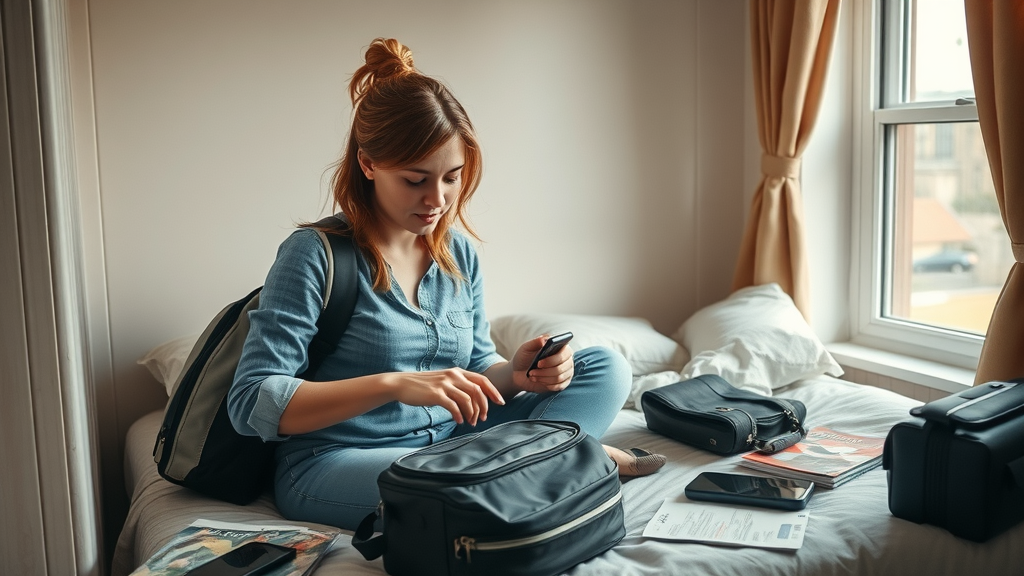Imagine waking up to the golden glow of sunrise, your heart racing with excitement as you overlook an unfamiliar city. Your journey is yours alone—a story of self-discovery, courage, and freedom. Solo travel for women isn't just about the places you visit; it's about claiming your space in a world that’s as safe and welcoming as you are adventurous. If you’ve ever dreamed of stepping beyond your comfort zone, this guide is for you.

Embrace the Journey: Why Solo Travel for Women Is Life-Changing
For countless women, solo travel offers a path to empowerment, self-knowledge, and unbounded inspiration. Embarking on a solo adventure isn’t just about ticking cities off a list—it’s the act of stepping into your own story, making decisions for yourself, and celebrating personal growth with each new experience. Solo travel for women unlocks a sense of independence; it serves as a catalyst for building confidence, resilience, and joy. Whether wandering down the cobblestone streets of an ancient city or hiking a misty national park at dawn, the journey imprints a special sense of accomplishment.
Being a solo female traveller means facing challenges head-on and learning to trust your instincts. It’s a life-changing approach to travel that encourages you to explore the world on your own terms, embracing both its possibilities and its complexities. Wellness and security are central, and with the right preparation, you can transform your journey into one of renewal and empowerment. This guide is tailored specifically for women seeking not only adventure but holistic well-being in every corner of the globe.
"Traveling solo is not just about crossing places off your list; it's about discovering your strength as a woman and nourishing your soul."
What You'll Learn from This Guide to Solo Travel for Women
- Top solo travel for women safety strategies
- Empowering destinations for solo female travel
- Wellness tips for female travellers on the road
- Expert recommendations for solo female traveller essentials
- Practical advice for overcoming challenges in solo female travel

1. Choose the Best Destinations for Solo Travel for Women
Choosing the right destination is the foundation of a transformative solo adventure. For women, prioritizing safety, accessibility, and wellness amenities is essential. The best destinations for solo female travel combine vibrant culture, user-friendly infrastructure, and a reputation where women travellers felt safe wandering on their own. From cities abuzz with energy to tranquil national parks designed for reflection and adventure, the choice shapes your journey. Travelers often say they fell in love with a place where the sense of belonging and personal security made all the difference, making the experience not just memorable, but truly liberating.
Some places truly stand out as great for solo female travellers—where you can explore delicious food markets, join a friendly walking tour, or relax in a city that is easy to navigate and full of opportunities for discovery. Consider your comfort, interests, and the level of independence you desire. Whether you’re drawn to national parks for the quiet thrill or cities that cater to female travelers with robust support networks, the world is full of exceptional destinations waiting for your unique perspective.
Discovering Safe Havens: Destinations for Solo Female Travellers
- Cities where female travellers feel safe: Tokyo, Singapore, Copenhagen, Reykjavik, and Toronto
- Top destinations for women travel: New Zealand, Portugal, Canada, Iceland, and Austria
- National parks for solo female traveler adventures: Banff (Canada), Yosemite (USA), Lake District (UK), Fiordland (New Zealand), Plitvice Lakes (Croatia)
| Destination | Crime Rate Index | Wellness Amenities |
|---|---|---|
| Reykjavik, Iceland | Low | Well-lit streets, friendly locals, wellness spas |
| Kyoto, Japan | Very Low | Efficient public transport, walkable neighborhoods, women's only accommodations |
| Vancouver, Canada | Moderate | Nature trails, healthcare access, diverse dining |
| Zurich, Switzerland | Very Low | High-tech security, focus on wellness, clean environment |
| Sydney, Australia | Low | Parks/beaches, solo group tour options, easy navigation |

2. Safety First: Empowering Tips for Solo Travel for Women
Safety is at the heart of every successful solo female travel experience. From bustling cities to remote hiking trails, understanding key safety principles ensures security without sacrificing the thrill of adventure. The most empowering action is preparation—know your surroundings, keep digital backups, and trust your intuition. Always research the safest neighborhoods, use secure transportation, and share your travel plans with trusted friends or family. Small habits can have a major impact: walking with confidence, staying alert in crowds, and carrying a charged phone provide layers of protection that make a real difference for solo travellers.
Develop a safety toolkit that matches your destination’s demands. Useful strategies include enrolling in local tours for orientation, avoiding travel after dark where possible, and using only reputable apps or taxi services. Many women also appreciate connecting with female-only forums or support groups before and during their journey. These shared communities offer real-time tips, whether you’re navigating a new city or seeking advice on national park safety for female travellers. With each proactive choice, you not only protect yourself but empower others to travel with confidence.
Essential Safety Gear for Solo Female Travel
- Personal alarms, portable locks, and safe travel bags
- Dressing for cultural respect and safety
- Digital security for solo female travellers

"Your well-being is your greatest asset on the road. Invest in your safety and wellness."
3. Wellness on the Road: Self-Care Tips for Solo Travel for Women
Solo travel isn’t just about reaching new places—it’s also an opportunity to care for your mind and body in exciting new settings. Prioritizing wellness during travel ensures you return home feeling stronger and more inspired. For solo female travellers, healthy routines are essential. Start with mindful habits like daily movement, meditation, or journaling to center your mind. Try new forms of exercise—perhaps a sunrise yoga class overlooking the ocean or a trail walk in a national park. These routines nurture both mental and physical wellness, creating the balance needed to truly thrive on the road.
Nutrition is another key pillar of travel wellness. Savoring local cuisine, especially fruits, vegetables, and healthy street food, is a delicious way to support your energy levels. Hydration is just as vital, so keep reusable water bottles handy and plan snack breaks throughout your day. If you find yourself feeling stressed or lonely—a common occurrence when traveling solo—reach out to friendly travellers or a community online. Remember: nurturing your well-being unlocks even greater adventures and personal growth.
Maintaining Mental and Physical Wellness as a Female Traveller
- Mindful routines for solo female travel
- Nutrition tips for traveling solo
- Managing stress and loneliness on your journey

4. Packing Smart: Solo Travel for Women Essentials
Smart packing is a game-changer for solo travel for women. The right essentials not only lighten your load but keep you healthy and prepared for anything. Opt for multi-purpose outfits that respect local customs and climates, pack health documents, and assemble a personal wellness kit with travel-friendly first-aid items. Reliable chargers, compact toiletries, and easy-access safety gear (like a doorstop alarm or portable lock) make travel smoother and less stressful for every female traveller.
Don’t forget comfort: invest in supportive shoes, breathable fabrics, and a daypack that’s both stylish and functional. Include lightweight wellness products—face masks, hand sanitizers, and reusable water bottles—to support self-care on the go. Remember, every item in your bag should enhance security or well-being, so be intentional, reduce clutter, and leave space for souvenirs from your solo adventure.
What Every Solo Female Traveller Needs in Her Bag
- Travel-friendly wellness products
- Health documents, chargers, and safety items
| Item | Purpose | Wellness/Safety Considerations |
|---|---|---|
| Personal alarm/whistle | Emergency signal | Alerts others in unsafe situations |
| Portable door lock | Hostel/hotel security | Improves peace of mind |
| Travel health kit | First-aid & wellness | Prevents minor issues from escalating |
| Reusable water bottle | Hydration | Keeps you energized and healthy |
| Comfortable shoes | Exploring | Avoids fatigue/injury |
| Charger & power bank | Connectivity | Ensures devices work in emergencies |
5. Finding Connection: Meeting People During Solo Travel for Women
Solo travel doesn’t mean being alone all the time—in fact, it often opens more doors for meaningful friendships. Engaging in group tours, joining local walking tours, or simply sharing a meal at a communal table can help you connect with like-minded travelers. Many cities offer meetups and experiences that are great for solo female travellers, fostering community while allowing you to expand your horizons. The key is to approach new situations with an open mind and a spirit of curiosity, as this invites memorable moments and deeper cultural understanding.
Respectful engagement is also vital when forming bonds on the road. Learning a few local phrases, understanding cultural etiquette, and participating in group tours or women’s only activities can enhance your sense of connection. The relationships you build may be brief, but their impact—new perspectives, lasting memories, and sometimes even lifelong friends—adds immeasurable value to your solo female travel journey.
Social Wellness: Navigating Friendships and Group Tours
- Best groups and tours for solo female travellers
- Making friends as a solo traveler
- Respectful cultural etiquette for women travel

6. Transport & Accommodation: Choosing What's Right for Solo Female Travellers
Transport and lodging are central to a safe and enjoyable solo female travel experience. Before booking, research how public transport is structured in your chosen destination—is it clean, well-lit, and easy to navigate? Opt for train systems, buses, and metros with high safety ratings and good reviews from other female travellers. When possible, schedule your arrivals in daylight hours and have directions ready to avoid confusion upon landing.
Accommodation should always prioritize your well-being. Choose hotels or hostels with excellent security measures, positive female traveler reviews, and, if possible, all-female dorms or women-only accommodations. Platforms recommended by fellow solo women travelers, such as trusted OTAs or booking sites, often feature listings where guests felt completely safe and welcome. Remember, the right lodging and transit plan transforms potential risks into seamless, enriching experiences.
Public Transport and Safe Lodging for Women
- Evaluating public transport safety as a solo female traveler
- Secure places to stay for solo female travellers
- Booking platforms recommended by solo women travelers

7. Mindset Matters: Cultivating Confidence When Traveling Solo
Confidence is both a mindset and a practice, especially when exploring the world solo. For female travellers, inner resilience is cultivated through intentional habits and self-reflection. Journaling, gratitude practices, and regular self-check-ins support emotional well-being and fortify you against travel stress or challenges. Building a positive mindset not only makes adventures more enjoyable, but also helps you bravely step into the unknown and overcome fears that may arise on the road.
Empowering yourself with affirmations and celebrating small wins—like successfully navigating the subway or making a new friend—helps reinforce your sense of capability. Remember, solo travel for women is not about avoiding risk, but learning to respond to it with confidence, clarity, and self-compassion. Each journey adds to your strength, shaping your identity as a traveler who belongs anywhere in the world.
Empowerment Techniques for Solo Female Travel
- Journaling and gratitude practices
- Building a positive solo female travel mindset
- Overcoming fear as a solo female traveller

8. Solo Female Travel Myths vs. Realities
Many myths surround solo travel for women—from safety fears to misconceptions about loneliness or extra cost. Yet, real-life experiences from seasoned travelers dispel these misconceptions. Most solo female travellers report feeling empowered, fulfilled, and surprised at how many wonderful people and supportive communities they encounter. While challenges exist, planning, knowledge, and a proactive mindset help you thrive as a solo adventurer. Seek advice from expert blogs, join women-only travel groups, and keep an open mind. Solo journeys can be rich with connection, adventure, and unexpected joy.
- Dispelling common perceptions about solo female travel
- How female travellers truly feel about solo trips
- Expert quotes from seasoned solo female travellers
"The world can be your sanctuary, and you are braver than you think."
FAQs on Solo Travel for Women
-
How do I start solo travel as a woman?
Start with destinations where female travellers felt safe, plan your route, ensure your documents are up to date, and pack with an emphasis on safety and wellness. Read blogs, join online travel communities, and start with a short trip to build confidence. -
What are the best safety tips for solo travel for women?
Always share your itinerary with someone you trust, stay aware of your surroundings, use secure accommodations, and trust your instincts. Invest in a personal alarm and portable lock, and be mindful of local customs and norms. -
How do I cope with loneliness while traveling solo?
Connect with fellow travelers via group tours or walking tours, journal your experiences, and practice self-care routines. Don’t hesitate to reach out to locals or join female-focused travel forums for support and new friendships. -
Is solo travel for women expensive?
It can be inexpensive if you plan wisely. Look for affordable hostels, group tours with no extra cost for solo travelers, and free walking tours. Spending decisions are yours alone, so you can prioritize experiences that matter most without unnecessary splurges.

People Also Ask: Where is the best place to travel solo for females?
Top Regions and Destinations for Female Travel
If you’re planning your first solo trip, some of the best regions include Scandinavia (with countries like Norway and Sweden), New Zealand, Japan, and parts of Western Europe like Portugal or the Netherlands. Cities such as Amsterdam, Copenhagen, and Melbourne are known to be not only beautiful and culturally vibrant, but also safe and welcoming to solo female travellers. These destinations have well-established tourism infrastructure, reliable public transport, and an abundance of activities that are great for solo exploration. Seek out areas with inclusive walking tours, dynamic food scenes, and plenty of serene public spaces for reflection and connection.
People Also Ask: Which city is the safest for solo female Travellers?
Safety Factors for Solo Female Travellers in Popular Cities
Several cities stand out globally for their focus on female traveler safety. Reykjavik in Iceland tops many lists, thanks to its low crime rates, friendly locals, and robust wellness offerings. Tokyo is celebrated for efficient public transportation, clean neighborhoods, and women-only options in both accommodation and transport. Cities that are easy to navigate—with clear signage and helpful support services—enhance the feeling of security for solo female travellers. Ultimately, the safest city for you is one where you feel comfortable, welcome, and free to explore day and night.
People Also Ask: Is it a good idea to travel alone as a woman?
Benefits and Wellness Considerations for Women Who Travel Solo
Traveling solo as a woman is not only a good idea—it’s an empowering step toward personal growth, confidence, and self-discovery. The wellness benefits are profound: increased resilience, improved emotional well-being, and a stronger sense of autonomy. While challenges exist, preparation and a positive mindset make the experience fulfilling and safe. Sharing meals, meeting new people, and indulging in local culture on your own schedule leads to refreshing experiences and lasting memories. Trust in your ability to navigate new spaces—your solo adventure awaits you!
People Also Ask: What is the best travel company for solo travel?
Top-Rated Group Tour Companies for Solo Female Travellers
Several travel companies specialize in supporting solo female travel with tailored group tours, cultural immersion, and security measures. Look for companies like Intrepid Travel, G Adventures, and Women on the Road—these organizations prioritize safety, offer women-only tours, and focus on unique experiences for solo women. Joining a group tour lets you meet like-minded travelers, reduces the stress of logistics, and provides a support system as you travel solo. Many companies now waive the extra cost often associated with solo bookings, making it easier for women to explore the world without compromise.
Key Takeaways for Solo Travel for Women
- Solo travel for women empowers and inspires personal growth
- Safety and wellness are integral to a fulfilling journey
- Community and connection are accessible, even when solo
- Confident solo female travel is achievable with knowledge

Ready to Begin Your Empowered Solo Travel Journey?
Take your first step today—every journey starts with a single decision fueled by curiosity, courage, and self-belief. The world is waiting for you.
Subscribe for more strategies on how to be a successful woman in every area of your life: http://spotlightonyoursuccess.com
 Add Row
Add Row  Add
Add 




Write A Comment